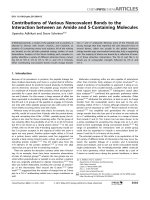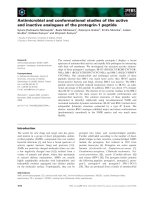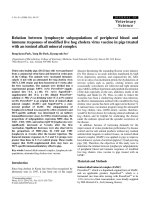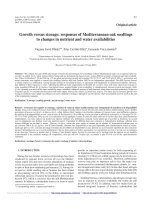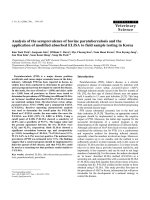In vitro and field responses of various active ingredients to Fusarium proliferatum species which causes Fusarium root rot disease in Indian mulberry (Morinda officinalis How.) in Thai
Bạn đang xem bản rút gọn của tài liệu. Xem và tải ngay bản đầy đủ của tài liệu tại đây (1.07 MB, 5 trang )
Life Sciences | Agriculture
Doi: 10.31276/VJSTE.61(2).47-51
In vitro and field responses of various active ingredients to Fusarium proliferatum
species which causes Fusarium root rot disease in Indian mulberry
(Morinda officinalis How.) in Thai Nguyen
Duong Thi Nguyen*, Nguyen Thi Nhu Hoa, Le Thi Kieu Oanh, Dang Kim Tuyen,
Nguyen Chi Hieu, Duong Son Ha, To Thi Ngan
Faculty of Agronomy, Thai Nguyen University of Agriculture and Forestry
Received 15 March 2019; accepted 30 May 2019
Abstract:
Fusarium proliferatum has been identified as the causal pathogen of Fusarium root rot of Ba kich (Morinda
officinalis) (FRRBK). No studies are available regarding the effectiveness of chemical treatments on the disease
incidence of FRRBK. The efficacy of five active ingredients (metconazole, prochloraz, tebuconazole, kresoximmethyl, and pyraclostrobin) from two chemical groups (demethylation inhibitors and quinone outside inhibitors)
in reducing three isolates (BKVN, BKDT, and BKPL) of F. proliferatum mycelial growth was tested in vitro.
The results indicate that only metconazole, prochloraz, and tebuconazole are highly effective in inhibiting the
mycelial growth of F. proliferatum. These were selected for investigation of their efficacy with regard to the disease
incidence of FRRBK in pot and in field conditions. Prochloraz and metconazole showed the highest efficacy and
significantly suppressed the disease incidence of FRRBK in pot and in field conditions.
Keywords: Ba kich, demethylation inhibitors, Fusarium proliferatum, Morinda officinalis, quinone outside
inhibitor.
Classification number: 3.1
Introduction
In Vietnam, Indian mulberry (Morinda officinalis How.)
is locally known as ‘Ba kich’ and is widely grown in many
mountainous provinces in the north of Vietnam. In Thai
Nguyen province, Ba kich is mainly planted in Vo Nhai, Dai
Tu, and Phu Luong districts for use in traditional medicine
as it is rich in various medicinal compounds. Therefore,
Ba kich is considered a cash crop, which brings substantial
income for small households.
Fusarium root rot of Ba kich (FRRBK), caused by
Fusarium proliferatum, is a widespread soilborne disease
that causes serious damage and significant economic
losses to Ba kich production in Vietnam in general and
in Thai Nguyen in particular [1]. Several bio-products
have been applied for the management of FRRBK in
Thai Nguyen province. Tests of the efficacy of a new bioproduct, MICROTECH-1(NL), were conducted in in vitro,
pot, nursery, and field conditions. In in vitro antagonistic
assay, MICROTECH-1(NL) significantly inhibited the
mycelial growth of F. proliferatum. Double application
of MICROTECH-1(NL) (applied both in the nursery and in
the pot soil) significantly reduced disease incidence and
markedly increased the number of plant-beneficial bacteria
and actinomycota in rhizoplane Ba kich. In field conditions,
double application of MICROTECH-1(NL) (both in nursery
and in field soils) significantly decreased disease incidence
compared to single application in either nursery or field.
However, bio-products usually act more slowly than
chemical fungicides. Therefore, to immediately suppress
the spread of the disease in nursery and field conditions
and to maintain the plant’s yield, chemical fungicides are
the better choice. In addition, no fungicides have been
identified and registered specifically to control FRRBK in
Vietnam; therefore, the effect of five active ingredients (a.i.)
that are either demethylation inhibitor (DMI) (metconazole,
prochloraz and tebuconazole) or quinone outside inhibitor
(QoI) (kresoxim-methyl and pyraclostrobin) fungicides on
the growth of the causal pathogen in vitro, and their efficacy
on reducing the disease incidence of FRRBK in pot and in
field conditions are assessed.
*Corresponding author: Email:
JUne 2019 • Vol.61 Number 2
Vietnam Journal of Science,
Technology and Engineering
47
Life Sciences | Agriculture
Materials and methods
Inoculum preparation
Three isolates of F. proliferatum, BKVN (Ba kich
growing in Vo Nhai district), BKDT (Dai Tu district),
and BKPL (Phu Luong district), which were previously
identified as causal agents of FRRBK in Thai Nguyen
province [1], were cultured on potato dextrose agar (PDA)
plates for three days at 250C in dark conditions. A piece
of PDA medium containing mycelium of each isolate was
grown in potato dextrose broth at 250C with shaking at 120
rpm. After seven days of incubation, the harvested fungal
suspensions were adjusted to 5×106 cfu/ml and used as
inocula for further experiments.
Plants and a.i.
One-year old Ba kich plants that had previously been
grown in small plastic pots (5×15×5 cm) were used. Five a.i.
(Table 1) were applied in this study to evaluate their effects
on the growth of F. proliferatum in in vitro condition; the
highly effective a.i. were selected for their efficacy on the
disease incidence of FRRBK in pot and in field conditions.
Table 1. Chemical active ingredients (a.i.) used in this study.
a.i.
Commercial name
a.i. tested (mg/l)
Group name
Mode of action
Metconazole
Workup 9 SL (Metconazole,
min. 94%)
1-10-100
Demethylation
inhibitors (DMI)
Sterol biosynthesis in
membranes
Prochloraz
Agrivil 250EC (Prochloraz,
min. 97%)
5-50-500
DMI
Sterol biosynthesis in
membranes
Tebuconazole
Folicur 430SC
(Tebuconazole, min. 95%)
3-30-300
DMI
Sterol biosynthesis in
membranes
Quinone outside
inhibitor (QoI)
Inhibition of
cell respiration
(mitochondria). Inhibition
of spore germination,
germ tube elongation,
mycelial growth and
sporulation.
QoI
Inhibition of
cell respiration
(mitochondria). Inhibition
of spore germination,
germ tube elongation,
mycelial growth and
sporulation.
Kresoxim-methyl
Pyraclostrobin
1Sosim 300SC (Kresoximmethyl, min. 95%)
Headline 200FS
(Pyraclostrobin)
10-100-1,000
10-100-1,000
replacing a.i. with sterile distilled water. Mycelial discs of
F. proliferatum of 5 mm diameter were transferred from
the seven-day old growth colony to the PDA plates, tested,
and incubated at 25±10C for seven days. Colony diameter
growth was measured and recorded on the seventh day after
treatment. The diameter of the F. proliferatum colony was
measured in two directions at right angles to each other, and
the average colony diameter was calculated. Measurement
of the growth of F. proliferatum was undertaken at intervals
of 24 hours for seven days. The inhibition percentage of
each a.i. on the mycelial growth of F. proliferatum was
determined on the seventh day of incubation following the
formula (1-Cn/Co) × 100, where Cn is the average diameter
of the F. proliferatum colony on the treatment plates, and
Co is the average diameter of F. proliferatum colony on the
control plates.
Effect of a.i. on disease incidence of FRRBK in pot
conditions
Based on the inhibition percentage (%) of each a.i. on the
mycelial growth of F. proliferatum, three a.i. were selected
and subjected to analysis of their effects on the disease
incidence of FRRBK in pot conditions (20×40×20 cm). An
eight-leaf (about one-year old) seedling was grown in each
pot containing F. proliferatum-infested soil. The preventive
and curative effects of each a.i. were determined according
to following experiments: (1) the a.i. was drenched in the
soil one week before pathogen inoculation, (2) the a.i. and
the pathogen spores were applied simultaneously, and (3)
the a.i. was drenched in the soil one week after pathogen
inoculation. Spore suspensions of BKVN, BKDT and
BKPL isolates were applied separately as drenches. These
experiments were replicated three times using a completely
randomised block design and 30 pots (30 plants) per
treatment.
Disease severity was recorded on 0 to 3 visual scales
as previously described by Trabelsi, et al. (2017) [2]. All
infected plants in each treatment were recorded for disease
incidence (%) using the following formula:
Mycelial growth inhibition of F. proliferatum by
different a.i.
The effect of different a.i. on the mycelial growth of F.
proliferatum was determined by growing F. proliferatum
on PDA plates (90 mm diameter). The experiment was
replicated five times (one Pestri plate per replication) and
the mean values were calculated. Each a.i. was separately
applied to 100 ml of sterilised PDA medium at 600C
before being divided equally into five Petri plates at the
rates indicated in Table 1. Control plates were prepared by
48
Vietnam Journal of Science,
Technology and Engineering
Disease incidence (%) =
(∑scale × number of plants infected)
(highest scale × total number of plants)
× 100
Efficacy of a.i. on FRRBK in field conditions
Three a.i. were applied in field experiments in Vo
Nhai district to determine their efficacy on FRRBK. The
experiments were replicated three times with a completely
randomised block design and a plot size of 24×6 m planted
with 100 Ba kich plants per treatment. The efficacy (E) of
the a.i. was calculated as follows:
JUne 2019 • Vol.61 Number 2
Life Sciences | Agriculture
Ta × Cb
E=1 -
Effect of a.i. on the disease incidence of FRRBK in pot
conditions
ET=a 1×-Cb
100
Tb × C
a
Tb × Ca
where: E: the efficacy of the active ingredient (%); Ta:
disease incidence in the treatment after applying the a.i.; Tb:
disease incidence in the treatment before applying the a.i.;
Ca: disease incidence in the control after application; and
Cb: disease incidence in the control before application.
Data analysis
The collected data were summarized as mean ± standard
deviation and analysed using Statistix 10 software.
Results and discussion
Effect of different a.i. on the inhibition of the mycelial
growth of F. proliferatum
In a dual-culture assay, the a.i. tested inhibited the
growth of F. proliferatum BKVN, BKDT, and BKPL isolates
by at least 48%; the highest values were obtained with
prochloraz and metconazole. All DMI fungicides showed
excellent activity in suppressing the mycelial growth of F.
proliferatum up to seven days of incubation. In particular,
metconazole and prochloraz completely suppressed colony
growth of F. proliferatum at the concentrations of 10, 100
and 50, 500 mg/l, respectively. At 1 and 5 mg/l, the two
a.i. inhibited up to more than 83-91% of the growth of F.
proliferatum BKVN, BKDT, and BKPL isolates (Fig. 1).
The application of another DMI fungicide, tebuconazole,
also inhibited the mycelial growth of F. proliferatum
BKVN, BKDT, and BKPL isolates by 70.38%, 71.80%, and
72.04%, respectively. The other two QoIs, kresoxim-methyl
and pyraclotrobin, showed low inhibition (lower than 80%
and 62%, respectively) (Fig. 1).
Proliferatum
BKVN
F.F.
proliferatum
BKVN
Treatment with a.i. one week before inoculation with F.
proliferatum significantly reduced the disease incidence of
FRRBK compared to the inoculated-untreated control. Of the
a.i. tested, prochloraz and metconazole showed the highest
suppression of disease incidence. The results indicated that
with prochloraz treatments, disease incidence ranged from
2.59% for the BKDT isolate to 3.70% for the BKPL isolate.
With metconazole treatments, disease incidence ranged
from 4.07% for the BKVN isolate to 4.81% for the BKPL
isolate. With the tebuconazole treatments, disease incidence
ranged from 7.04% for the BKVN isolate to 9.26% for the
BKDT isolate (Table 2).
Table 2. Disease incidence when Ba kich plants were treated
with a.i. one week before the plants were inoculated with F.
proliferatum spores.
Disease incidence (%)
a.i.
F. proliferatum
BKVN
F. proliferatum
BKDT
F. proliferatum
BKPL
Metconazole
4.07c
4.44c
4.81c
Prochloraz
3.33c
2.59c
3.70c
Tebuconazole
7.04b
9.26b
8.15b
Inoculated-untreated control
81.11a
80.37a
82.59a
Non-inoculated-untreated
control
0.00d
0.00d
0.00d
p
<0.05
<0.05
<0.05
CV(%)
3.25
8.67
6.37
LSD0.05
0.62
1.68
1.25
Note: values followed by a different letter(s) in the same column
are significantly different (p<0.05).
Proliferatum
BKDT
F.F.proliferatum
BKDT
Proliferatum
BKPL
F.F.proliferatum
BKPL
120.00
Mycelial growth inhibition (%)
100.00
80.00
60.00
40.00
20.00
0.00
1
Metconazole
10
100
Metconazole
5
Prochloraz
50
Prochloraz
3
500 Tebuconazole
30
ActiveTebuconazole
ingredient
300
10
100
1.000
Kresoxim-methyl
Kresoxim-methyl
10
100
1.000
Pyraclostrobin
Pyraclostrobin
Fig. 1. The inhibition of the tested a.i. on mycelial growth of F. prolifertum isolates BKVN, BKDT, and BKPL. Three different
concentrations of each a.i. (mg/l) were amended into PDA plates before the culturing of each isolate. Colony growth in diameter was
measured and the inhibition values (%) were calculated.
JUne 2019 • Vol.61 Number 2
Vietnam Journal of Science,
Technology and Engineering
49
Life Sciences | Agriculture
The decrease of disease incidence when a.i. were applied
simultaneously with inoculation by F. proliferatum spores
showed similar trends, although the disease incidence
was higher than when a.i. were applied one week before
inoculation with F. proliferatum. Disease incidence in
treatments with prochloraz or metconazole was statistically
differentiated compared to treatments with tebuconazole
and the inoculated-untreated control. Disease incidence
with all a.i. ranged from 7.78% with prochloraz for the
BKDT isolate to 13.70% with tebuconazole with BKVN
isolate (Table 3).
Table 4. Disease incidence when Ba kich plants were treated
with a.i. one week after the inoculation with F. proliferatum
spores.
Active ingredient
Table 3. Disease incidence when Ba kich plants were treated
with a.i. at the same time as the plants were inoculated with F.
proliferatum spores.
Disease incidence (%)
a.i.
BKVN
BKDT
BKPL
Metconazole
9.26c
9.63c
10.74c
Prochloraz
8.15c
7.78c
8.52c
Tebuconazole
13.70b
15.56b
17.78b
Inoculated-untreated control
81.11a
80.37a
82.59a
Non-inoculated-untreated control
0.00
0.00
0.00d
d
d
p
<0.05
<0.05
<0.05
CV(%)
4.18
12.74
6.12
LSD0.05
0.74
2.28
1.14
Disease incidence (%)
BKVN
BKDT
BKPL
Metconazole
18.89c
18.52bc
20.74b
Prochloraz
14.81d
13.70c
14.07c
Tebuconazole
22.22b
23.33b
20.37b
Inoculateduntreated control
81.11a
80.37a
82.59a
Non-inoculateduntreated control
0.00e
0.00d
0.00d
p
<0.05
<0.05
<0.05
CV(%)
2.52
10.89
5.41
LSD0.05
0.55
2.35
1.24
Note: values followed by a different letter(s) in the same column
are significantly different (p<0.05).
Efficacy of a.i. on FRRBK in field conditions
Note: values followed by a different letter(s) in the same column
are significantly different (p<0.05).
Treatment with a.i. one week after inoculation with F.
proliferatum also reduced disease incidence and showed
similar trends. For the treatment with prochloraz, disease
incidence was 13.70% for the BKDT isolate and 14.81%
for the BKVN isolate. For the treatments with metconazole,
disease incidence ranged from 18.52% for the BKDT
isolate to 20.74% for the BKPL isolate. Disease incidence
was more than 20% and reached 23.33% with tebuconazole
(Table 4).
Double application of a.i. in the field significantly
decreased disease incidence in comparison to the control.
Among the three tested a.i., prochloraz showed the highest
efficacy on FRRBK in the field condition. Its efficacy was
67.75% after one month of treatment, reached a maximum
of more than 69% after 2-3 months after treatment, and
started decreasing thereafter. Treatments with metconazole
also significantly reduced the disease incidence of FRRBK,
resulting in efficacy of 61.63% at one month after treatment;
this reached a maximum of 65.66% at two months
after treatment before gradually decreased thereafter.
Tebuconazole also suppressed disease incidence of FRRBK
in field conditions; however, its efficacy was lower than that
of either prochloraz or metconazole (Table 5).
Table 5. Efficacy of different a.i. on FRRBK in field conditions.
1 MAT
2 MAT
3 MAT
4 MAT
5 MAT
Active
ingredient
DI (%) before
treatment
DI (%)
Efficacy (%)
DI (%)
Efficacy (%)
DI (%)
Efficacy (%)
DI (%)
Efficacy (%)
DI (%)
Efficacy (%)
Metconazole
6.56
10.33
61.63b
12.67
65.66a
16.33
61.88ab
23.00
57.98ab
33.89
53.87b
Prochloraz
6.22
8.33
67.75a
10.78
69.81a
12.56
69.87a
18.33
64.71a
27.78
60.43a
Tebuconazole
6.33
11.44
56.01
15.00
58.38
17.78
58.08
23.56
53.90
33.78
52.10b
Control
6.44
26.56
-
36.78
-
43.44
-
54.00
-
72.22
-
c
b
b
b
p
<0.05
<0.05
<0.05
<0.05
<0.05
CV(%)
4.95
6.10
9.91
10.64
7.81
LSD0.05
1.87
2.41
3.84
3.83
2.65
Note: DI: disease incidence, MAT: month after treatment. Values followed by a different letter(s) in the same column are significantly
different (p<0.05).
50
Vietnam Journal of Science,
Technology and Engineering
JUne 2019 • Vol.61 Number 2
Life Sciences | Agriculture
F. proliferatum has been reported as the causal pathogen
of FRRBK in Vietnam [1]. To investigate the effects of
different fungicides on F. proliferatum, DMI (metconazole,
prochloraz, and tebuconazole) and QoI (kresoximmethyl and pyraclostrobin) fungicides were evaluated in
this study. Metconazole, prochloraz, and tebuconazole
are sterol demethylation inhibitors that inhibit the
C-14 α-demethylation of 24-methylenedihydrolanosterol, a
precursor of the ergosterol of fungi [3]. Kresoxim-methyl
and pyraclostrobin are QoIs that inhibit mitochondrial
respiration by binding to cytochrome c oxidoreductase,
leading to an energy deficiency due to a lack of Adenosine
triphosphate (ATP) [4].
Conclusions
Our study reveals that DMI fungicides are more effective
in inhibiting the mycelial growth of F. proliferatum than are
QoI fungicides (Fig. 1). Among the tested a.i., prochloraz
and metconazole were the most effective fungicides for
inhibiting mycelial growth of F. proliferatum. Tebuconazole,
another DMI fungicide, exhibited lower levels of inhibitory
effects on the growth of F. proliferatum. The two QoI
fungicides, kresoxim-methyl and pyraclostrobin, were
the least effective (Fig. 1). Our results suggest that F.
proliferatum is more sensitive to prochloraz and metconazole
than to tubecunazole, kresoxim-methyl, and pyraclostrobin.
The most effective fungicide was prochloraz, followed by
metconazole and tebuconazole, among the a.i. tested for
the inhibition of mycelial growth of F. proliferatum. In pot
and field conditions, prochloraz had the highest efficacy
in suppressing disease incidence in comparison with other
fungicides and the control.
[2] R. Trabelsi, H. Sellami, Y. Gharbi, A. Krid, M. Cheffi, S. Kammoun,
M. Dammak, A. Mseddi, R. Gdoura, M.A. Triki (2017), “Morphological and
molecular characterization of Fusarium spp. associated with olive trees dieback
in Tunisia”, 3 BioTech., 7(1), Doi: 10.1007/s13205-016-0587-3.
Previous studies indicate that DMI fungicides effectively
control different diseases caused by Fusarium, such as
F. graminearum, which causes Fusarium head blight in
wheat [5], F. oxysporum, which causes Fusarium wilt in
bananas [6], F. subglutinans and F. temperatum, which
causes maize stalk rot [7], F. proliferatum, which causes
Fusarium bulb rot in garlic [8], and F. proliferatum, which
contaminates cereals [9]. Other studies have also revealed
the greater efficacy of DMI fungicides on Fusarium species
than the other groups of fungicides. Among those groups,
prochloraz and tebuconazole have been proven to be more
effective against Fusarium spp. than kresoxim-methyl [10,
11]. Fusarium species were more sensitive to fungicides
belonging to the DMI group but were intrinsically resistant
to complex III respiration inhibitors [12].
Our results show the high effectiveness of DMI
fungicides (prochloraz, metconazole, and tebuconazole)
in inhibiting mycelial growth of F. proliferatum, although
tebuconazole failed to control FRRBK in field conditions
(its efficacy was as low as 58%), suggesting that there
were some factors might affect the efficacy of a.i. in field
conditions. These are pathogen inocula in soil, fungicide
application, soil temperature and relative humidity, and soil
fertility [9, 13, 14].
Of the tested a.i., prochloraz and metconazole showed the
highest efficacy in inhibiting the growth of F. proliferatum
in in vitro conditions, and significantly suppressed disease
incidence of FRRBK in pot and in field conditions.
The authors declare that there is no conflict of interest
regarding the publication of this article.
REFERENCES
[1] D.T. Nguyen, N.C. Hieu, H.T.B Thao, T.X. Hoat (2019), “Molecular
characterization of Fusarium proliferatum associated with root rot disease
of Indian mulberry (Morinda officinalis How.) in Viet Nam”, Archives of
Phytopathology and Plant Protection, 52(1-2), pp.200-217.
[3] Y. Yin, X. Liu, B. Li, Z. Ma (2009), “Characterization of sterol
demethylation inhibitor-resistant isolates of Fusarium asiaticum and F.
graminearum collected from wheat in China”, Phytopathol., 99(5), pp.487-497.
[4] B. Ma (2006), Azoxystrobin sensitivity and resistance management
strategies of Magnaporthe grisea causing gray leaf spot on perennial ryegrass
(Lolium perenne) turf, Ph.D. thesis, Pennsylvania State University, University
Park, USA.
[5] D. Ivić, Z. Sever, B. Kuzmanovska (2011), “In vitro sensitivity of
Fusarium graminearum, F. avenaceum and F. verticillioides to carbendazim,
tebuconazole, flutriafol, metconazole and prochloraz”, Pestic. Phytomed., 26(1),
pp.35-42.
[6] B. Nel, C. Steinber, N. Labuschagne, A. Viljoen (2007), “Evaluation
of fungicides and sterilants for potential application in the management of
Fusarium wilt of banana”, Crop. Prot., 26(4), pp.697-705.
[7] J.H. Shin, J.H. Han, J.K. Lee, K.S. Kim (2014), “Characterization of
the maize stalk rot pathogens Fusarium subglutinans and F. temperatum and
the effect of fungicides on their mycelial growth and colony formation”, Plant
Pathol. J., 30(4), pp.397-406.
[8] L.G. Paton, M.D.R. Marrero (2016), “In vitro and field efficacy of three
fungicides against Fusarium bulb rot of garlic”, Eur. J. of Plant Pathol., 148(2),
pp.321-328.
[9] P. Marin, A. de Ory, A. Cruz, N. Magan, M.T. González-Jaen (2013),
“Potential effects of environmental conditions on the efficiency of the antifungal
tebuconazole controlling Fusarium verticillioides and Fusarium proliferatum
growth rate and fumonisin biosynthesis”, Int. J. Food Microbiol., 165(3),
pp.251-258.
[10] C. Müllenborn, U. Steiner, M. Ludwig, E.C. Oerke (2008), “Effect of
fungicides on the complex of Fusarium species and saprophytic fungi colonizing
wheat kernels”, Eur. J. of Plant Pathol., 120(2), pp.157-166.
[11] J. Amini, D. Sidovich (2010), “The effects of fungicides on Fusarium
oxysporum f. sp. lycopersici associated with fusarium wilt of tomato”, J. Plant
Protect. Res., 50(2), pp.172-178.
[12] M. Pasquali, F. Spanu, B. Scherm, V. Balmas, L. Hoffmann, K.E.
Hammond-Kosack, M. Beyer, Q. Migheli (2013), “FcStuA from Fusarium
culmorum controls wheat foot and root rot in a toxin dispensable manner”,
PLOS ONE, 8(2), e57429, Doi: 10.1371/journal.pone.0057429.
[13] S.C. Vyas (1988), Nontarget effects of agricultural fungicides, London,
UK: CRC Press.
[14] H.F. Schwartz, S.K. Mohan (2008), Compendium of onion and garlic
diseases and pests, 127pp, Ed. APS Press.
JUne 2019 • Vol.61 Number 2
Vietnam Journal of Science,
Technology and Engineering
51
